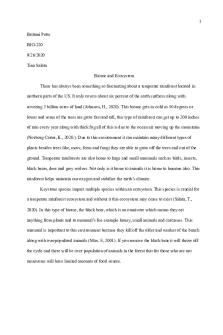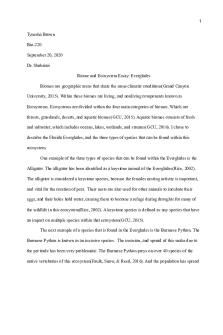Biome and Ecosystem PDF

| Title | Biome and Ecosystem |
|---|---|
| Author | Tiffany Lewis |
| Course | Environmental Science |
| Institution | Grand Canyon University |
| Pages | 5 |
| File Size | 80.4 KB |
| File Type | |
| Total Downloads | 6 |
| Total Views | 173 |
Summary
Explaining the Biome and the Ecosystem....
Description
First Last: Tiffany Lewis Grand Canyon University: BIO 220 01/30/2022 Shrestha Samridi Biome and Ecosystem Essay Ecosystems are made up of living and non-living animals and the conditions in which they exist. An environment refers to everything in a biome's or ecosystem's surroundings. Biomes that are well-known and have similar climate conditions make up the ecosystem. The aquatic biome is a biome that originates in water. Aquatic biomes contain wetlands formed when waste water contains the soil surface. Observers can forecast species and plants that live in the wetland by looking at how the soil develops and how much water is absorbed. “Wetlands are critical, even though biomes act as sponges for all the other biomes” (Ramos, 2018, pg. 3). “Marshes, bogs, and swaps are examples of wetlands that act as sponges for all the other biomes” (Ramos, 2018, pg. 3). The wetland collects extra water during storms with heavy rains. This important aquatic biome is home to endangered, invasive, and keystone species that are critical to the environment's survival. Endangered species are animals that are on the verge of becoming extinct. “Two reasons that can lead to an animal's death are genetic variation and habitat decline” (Bester, 2020, para 12). 12). Stopping the destruction of ecosystems or placing them in jeopardy is the only strategy to prevent habitat loss. Because of the species reproduction process, genetic differences are difficult to avoid. “Water loss and pollution, as well as grazing, which worsens soil compaction and eliminates vegetation, are other threats to these endangered species” (What can you do," 2020, para. 15). The number of pesticides and herbicides used on lawns to avoid this problem, as
these chemicals can leak into groundwater. Water is necessary for life; thus, protecting the water supply around us can help these endangered animals survive in these biomes. An invasive species is one that does not belong in a certain habitat but has managed to establish itself there. Killer algae and green grabs are invasive species.These nonnative species have the potential to cause significant economic and ecological harm to the ecosystem. Invasive species have the potential to wipe out a species, resulting in reduced biodiversity, a scarcity of resources, and the extinction of the species (Bonneau et a, 2017, pg. 3). Invasive species can do so much damage to the environment that may be life-threatening. Nonnative species can infect native animals with diseases they have never seen before. “These interactions are vital to the wetland's other biome dynamics, particularly in watery biomes like wetlands. (Nonnative Species," 2017, para. 9). More security checkpoints across state and county boundaries will help prevent invading species from entering current settings. Nondomestic pet owners should be more responsible and not let their animals out if they grow excessive. Bystanders should be able to call a hotline to report exotic non-native wildlife. Invasive species can be controlled by performing these things, but they will always exist in our biomes and habitats. Species with a traditional prey-predator interaction are known as keystone species. These interactions are critical to the wetland's other dynamics in biomes, especially aquatic biomes like wetlands. The biome's environment is balanced due to the existence of predatory and prey species. “The wetland would be in full disorder and would perish if the keystone species were not present” (Bonneau et al, 2017, pg. 4). If the keystone species went extinct, the predetor would have no natural food, leading to battle of death for the remaining food and cannibalism. The food chain would go insane, causing the populations of numerous prior species to skyrocket.
If the pre-keystone species went extinct, the predator would have no natural food, leading to a battle to the death for the remaining food and cannibalism. With keystone species present, the equilibrium Is maintained, allowing the biomes to be at ease and the wetlands to be safe. Water is the basis of life, as it is required for the survival of all animal and plant species. This is why the aquatic and wetland biomes are so important. The above two biomes are home to a diverse range of creatures, improve water quality, and heal and reverse damage that has already happened. Endangered, keystone, and invasive species are all equally important. These species are critical to the ecosystem's survival.
Reference Bester, C. (2020) Threatened + Endangered species. Retrieved from https://www.floridamuseum.ufl.edu/southflorida/regions/everglades/endangered-species/ Bonneau, M., Borkhataria, R., Hart, K., Larson, B., McCleery, R., Reed, R., Reichert, B., Sovie, A., & Udell, B. (2017). Urbanization may limit impacts of an invasive predator on native mammal diversity. Diversity and Distributions, 4, 355. Retrieved from https://lopes.idm.oclc.org/login?url=https://search.ebscohost.com/login.aspx? direct=true&db=edsgao&AN=edsgcl.483803231&site=eds-live&scope=site National Park Service. (2017). Nonnative Species. Retrieved from https://www.nps.gov/ever/learn/nature/nonnativespecies.htm Ramos, J. (2018) 5 things you should know about wetland. Retrieved from https://www.conservation.org/blog/5-things-you-should-know-about-wetlands? gclid=Cj0KCQiAyp7yBRCwARIsABfQsnQDp7r3opVyZWQCttcjeyTVb8gkQp5gFcCtO9UpO-mi1IsIAYIHYcaAk_FEALw_wcB What You Can Do to Protect the Florida Everglades Ecosystem. (2020). Retrieved from https://
www.evergladesholidaypark.com/what-you-do-protect-everglades...
Similar Free PDFs

Biome and Ecosystem
- 5 Pages

Biome and Ecosystem
- 4 Pages

Biome and Ecosystem Essay
- 3 Pages

Biome and Ecosystem Essay
- 4 Pages

Biome and Ecosystem
- 5 Pages

Biome and Ecosystem Essay
- 4 Pages

Biome and ecosystem Essay
- 3 Pages

Biome and Ecosystem Essay
- 3 Pages

Ecosystem report
- 15 Pages

Biome Chart
- 2 Pages

Biome Table
- 4 Pages
Popular Institutions
- Tinajero National High School - Annex
- Politeknik Caltex Riau
- Yokohama City University
- SGT University
- University of Al-Qadisiyah
- Divine Word College of Vigan
- Techniek College Rotterdam
- Universidade de Santiago
- Universiti Teknologi MARA Cawangan Johor Kampus Pasir Gudang
- Poltekkes Kemenkes Yogyakarta
- Baguio City National High School
- Colegio san marcos
- preparatoria uno
- Centro de Bachillerato Tecnológico Industrial y de Servicios No. 107
- Dalian Maritime University
- Quang Trung Secondary School
- Colegio Tecnológico en Informática
- Corporación Regional de Educación Superior
- Grupo CEDVA
- Dar Al Uloom University
- Centro de Estudios Preuniversitarios de la Universidad Nacional de Ingeniería
- 上智大学
- Aakash International School, Nuna Majara
- San Felipe Neri Catholic School
- Kang Chiao International School - New Taipei City
- Misamis Occidental National High School
- Institución Educativa Escuela Normal Juan Ladrilleros
- Kolehiyo ng Pantukan
- Batanes State College
- Instituto Continental
- Sekolah Menengah Kejuruan Kesehatan Kaltara (Tarakan)
- Colegio de La Inmaculada Concepcion - Cebu




